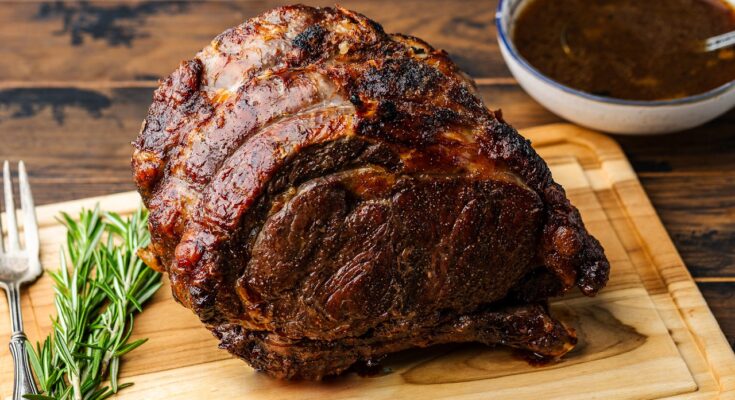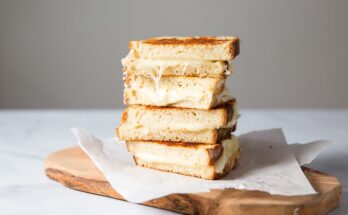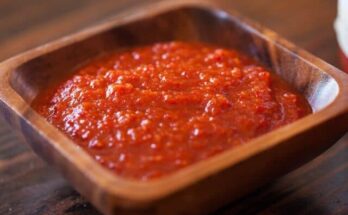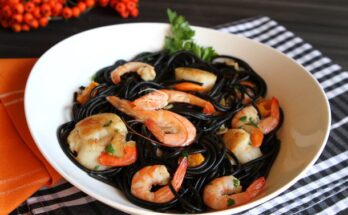Ribeye Roast Recipe: Nothing screams special occasion like a perfectly cooked ribeye roast. This tender, juicy cut of beef is a crowd-pleaser, thanks to its rich marbling and flavor.
Whether it’s for a holiday feast or a family dinner, ribeye roast combines simplicity with decadence, making it the ultimate centerpiece for your table.
In this step-by-step guide, I’ll show you how to achieve a perfectly cooked ribeye roast that will leave your guests asking for seconds.
What is a Ribeye Roast?
Ribeye roast comes from the rib section of the cow, known for its rich marbling and tender texture. Unlike its smaller counterpart, the ribeye steak, the roast is a larger, whole cut that can serve multiple people. This cut delivers all the flavor of a ribeye steak but in a format perfect for feeding a crowd.
Why Choose Ribeye Roast?
The ribeye roast is prized for its exceptional flavor and tenderness, making it a favorite for festive occasions or weekend feasts. It has a buttery texture and a hearty flavor that pairs beautifully with a variety of sides. Plus, it’s versatile—you can season it simply or dress it up with herbs and spices for a gourmet flair.
Ingredients for the Perfect Ribeye Roast
Key Ingredients
To make a perfect ribeye roast, you’ll need:
Main Ingredients:
- 1 bone-in or boneless ribeye roast (4-6 pounds).
- Kosher salt and freshly ground black pepper.
Optional Ingredients:
- Garlic cloves (minced or whole).
- Fresh rosemary and thyme.
- Olive oil or butter for added richness.
Importance of High-Quality Ingredients
Start with a well-marbled ribeye roast for maximum flavor and tenderness. Opt for USDA Prime or Choice-grade beef for the best results. Fresh herbs and high-quality salt will elevate the roast’s natural flavors, so don’t skimp here!
Tools You’ll Need
Essential Cooking Tools
- Roasting pan with a rack: Ensures even cooking and proper air circulation.
- Meat thermometer: A must for perfectly cooked beef.
- Cutting board and sharp knife: For carving the roast with ease.
Optional Tools
- Kitchen twine: Useful if your roast needs tying for even cooking.
- Basting brush: Helps distribute melted butter or juices evenly.
Preparing the Ribeye Roast
Step 1: Preparing the Meat
Before you start, let the ribeye roast come to room temperature—this ensures even cooking. If your roast has an uneven shape, use kitchen twine to tie it into a uniform size. This step is optional but helpful for consistent results.
Step 2: Seasoning the Roast
Generously coat the roast with kosher salt and freshly cracked black pepper. For extra flavor, rub minced garlic and chopped herbs like rosemary and thyme onto the meat. Let the seasoned roast sit for at least 30 minutes to absorb the flavors.
Step 3: Preheating the Oven
Preheat your oven to 450°F (232°C). A high initial temperature helps sear the outside of the roast, locking in juices. Once preheated, place the rack in the center position.
Cooking the Ribeye Roast
Step 1: Searing the Roast
Before roasting, heat a skillet over medium-high heat with a bit of oil. Sear the ribeye roast on all sides until golden brown. This caramelizes the exterior, adding flavor and texture.
Step 2: Roasting the Ribeye
Place the seared roast in the prepared roasting pan with the fat side up. Reduce the oven temperature to 325°F (163°C) and roast until the internal temperature reaches your desired level of doneness (e.g., 130°F for medium-rare). Use a meat thermometer to check the temperature at the thickest part of the meat.
Step 3: Resting the Meat
Once cooked, remove the roast from the oven and tent it with foil. Let it rest for 15-20 minutes. This step allows the juices to redistribute, ensuring every bite is tender and juicy.
Carving and Serving
How to Carve a Ribeye Roast
Use a sharp knife to carve the roast into slices about ½ inch thick. If your roast is bone-in, carefully cut along the bone to remove it before slicing. Serve the slices on a warm platter for an elegant presentation.
Serving Suggestions
Pair your ribeye roast with classic sides like mashed potatoes, roasted vegetables, or a fresh green salad. Don’t forget a rich gravy or creamy horseradish sauce for an extra layer of flavor.
Pro Tips for the Best Ribeye Roast
- Use a meat thermometer for precision—guesswork leads to disappointment.
- Don’t skip the resting period; it’s key for juicy meat.
- Experiment with flavors! Try a spice crust or a mustard rub for variation.
Variations of Ribeye Roast Recipe
- Herb-Crusted Ribeye Roast: Coat the roast with a mixture of breadcrumbs, parsley, and garlic.
- Smoked Ribeye Roast: Use a smoker for a deep, smoky flavor.
- Slow Cooker Method: For a hands-off approach, cook the roast in a slow cooker with onions and broth.
FAQs about Ribeye Roast Recipe
1. What is the best temperature to cook a ribeye roast?
Cooking a ribeye roast perfectly involves roasting it at a moderate temperature to ensure it’s evenly cooked. Preheat your oven to 350°F (175°C) for the best results. This temperature allows the roast to cook slowly, enhancing its natural flavors and tenderness.
2. How long should I cook a ribeye roast?
The cooking time for a ribeye roast depends on how well-done you prefer your meat. Generally, aim for about 20 minutes per pound for medium-rare. Always use a meat thermometer to check that the internal temperature has reached 135°F (57°C) for medium-rare or 145°F (63°C) for medium.
3. Should I sear my ribeye roast before roasting?
Yes, searing the ribeye roast before roasting is highly recommended. Searing it on all sides in a hot skillet helps to lock in the juices and gives the roast a delicious, caramelized crust.
4. What herbs and spices work well with a ribeye roast?
Rosemary, thyme, garlic, and black pepper are excellent choices for seasoning a ribeye roast. These herbs and spices complement the rich flavors of the meat without overpowering it.
5. How do I keep my ribeye roast moist while cooking?
To keep your ribeye roast moist, ensure not to overcook it. Keeping a tray of water in the oven during the roasting process can also help maintain moisture. Additionally, basting the roast periodically with its juices can promote a juicy, flavorful finish.
6. Can I cook vegetables with my ribeye roast?
Absolutely! Roasting vegetables in the same pan as your ribeye roast is a great way to absorb all the flavors. Potatoes, carrots, and onions make for a hearty and convenient side dish that cooks as your roast does.
7. What should I do with leftovers?
Leftover ribeye roast can be stored in an airtight container in the refrigerator for up to three days. Reheat it gently, or use it cold in sandwiches, salads, or wraps for a delicious next-day meal.



